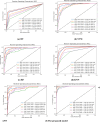Enhanced melanoma and non-melanoma skin cancer classification using a hybrid LSTM-CNN model
- PMID: 40640352
- PMCID: PMC12246411
- DOI: 10.1038/s41598-025-08954-8
Enhanced melanoma and non-melanoma skin cancer classification using a hybrid LSTM-CNN model
Abstract
Melanoma is the most dangerous type of skin cancer. Although it accounts for only about 1% of all skin cancer cases, it is responsible for the majority of skin cancer-related deaths. Early detection and accurate diagnosis are crucial for improving the prognosis and survival rates of patients with melanoma. This paper presents a novel approach for the automatic identification of cutaneous lesions by integrating convolutional neural networks (CNNs) with long short-term memory (LSTM) networks. In the proposed approach, the image of each skin lesion is divided into a sequence of tags of a particular size, which is then treated by the LSTM network to capture temporal dependence and relevant relationships between different spatial regions. This patching sequence allows the modeling system to analyze the local pattern in the image. Time CNN layers are later used to extract spatial functions, such as texture, edges, and color variation, on each patch. A Softmax layer is then used for classification, providing a probability distribution over the possible classes. We use the HAM10000 dataset, which contains 10,015 skin lesion images. Experimental results demonstrate that the proposed method outperforms recent models in several metrics, including accuracy, recall, precision, F1 score, and ROC curve performance.
Keywords: Convolutional neural networks; HAM10000 dataset; Long short-term memory; Skin cancer.
© 2025. The Author(s).
Conflict of interest statement
Declarations. Competing interests: The authors declare no competing interests.
Figures
















Similar articles
-
Automatic melanoma detection using an optimized five-stream convolutional neural network.Sci Rep. 2025 Jul 1;15(1):22404. doi: 10.1038/s41598-025-05675-w. Sci Rep. 2025. PMID: 40594676 Free PMC article.
-
Short-Term Memory Impairment.2024 Jun 8. In: StatPearls [Internet]. Treasure Island (FL): StatPearls Publishing; 2025 Jan–. 2024 Jun 8. In: StatPearls [Internet]. Treasure Island (FL): StatPearls Publishing; 2025 Jan–. PMID: 31424720 Free Books & Documents.
-
Skin-CAD: Explainable deep learning classification of skin cancer from dermoscopic images by feature selection of dual high-level CNNs features and transfer learning.Comput Biol Med. 2024 Aug;178:108798. doi: 10.1016/j.compbiomed.2024.108798. Epub 2024 Jun 25. Comput Biol Med. 2024. PMID: 38925085
-
Integrating Patient Data Into Skin Cancer Classification Using Convolutional Neural Networks: Systematic Review.J Med Internet Res. 2021 Jul 2;23(7):e20708. doi: 10.2196/20708. J Med Internet Res. 2021. PMID: 34255646 Free PMC article.
-
A rapid and systematic review of the clinical effectiveness and cost-effectiveness of paclitaxel, docetaxel, gemcitabine and vinorelbine in non-small-cell lung cancer.Health Technol Assess. 2001;5(32):1-195. doi: 10.3310/hta5320. Health Technol Assess. 2001. PMID: 12065068
References
-
- Miller, K. D. et al. Cancer treatment and survivorship statistics. CA Cancer J. Clin.69(5), 363–385 (2022). - PubMed
-
- Ferlay, J. et al. Cancer incidence and mortality patterns in Europe: Estimates for 40 countries and 25 major cancers in 2018. Eur. J. Cancer103, 356–387 (2018). - PubMed
-
- Kasmi, R. & Mokrani, K. Classification of malignant melanoma and benign skin lesions: Implementation of automatic ABCD rule. IET Image Process.10(6), 448–455 (2016).
MeSH terms
LinkOut - more resources
Full Text Sources
Medical

